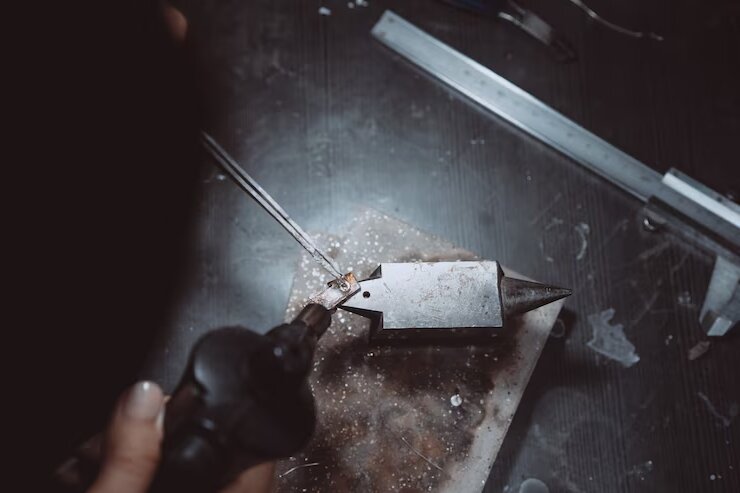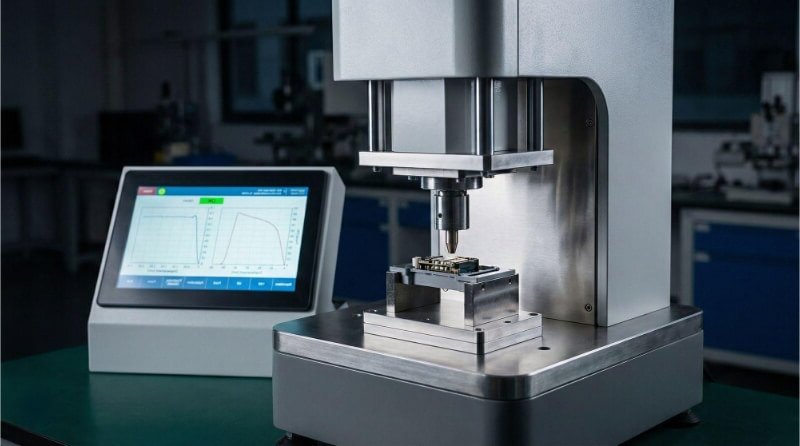When it comes to welding, different methods can help achieve the desired result. One such method is Shielded Metal Arc Welding (SMAW), or stick welding. This process is widely used, but many people may not fully understand how it works or when to use it. In this guide, we will explain the process, benefits, and applications of SMAW to help you make the right decision about when and how to use it.
SMAW is a welding process where an electric arc forms between a consumable electrode and the workpiece. The heat generated by the arc melts the electrode, creating a pool of molten metal. This metal then fuses with the base material, forming a strong bond. The coating on the electrode creates a shielding gas that protects the weld from contamination.
Now that you understand the basics, let’s explore how SMAW is used in different situations and why it remains a popular choice in welding. Its flexibility and ease of use make it a great option for many types of projects.

How Does Shielded Metal Arc Welding Work?
SMAW uses an electric arc that forms between the welding electrode and the workpiece. The heat from the arc melts the electrode, which fuses with the base material. As the molten metal cools, it solidifies and forms a strong bond. The flux coating on the electrode creates a gas that shields the molten metal from contamination. This ensures the weld is strong and of good quality.
Key Components of SMAW
Several components play a role in SMAW, each crucial to the process.
The Electrode
The electrode in SMAW is a metal rod coated with flux. The heat from the arc melts the electrode, and the molten metal forms the weld. The flux coating creates gases that protect the weld from contaminants in the air.
The Welding Machine
The welding machine provides the electrical current to form the arc between the electrode and the base material. The machine can use alternating current (AC) or direct current (DC), depending on the type of material being welded and the application.
The Power Supply
The power supply gives the welding machine the correct voltage and current. Setting the right power supply is key for a stable arc and a high-quality weld.
The Shielding Gas
The flux coating around the electrode generates shielding gas. This gas protects the molten weld pool from oxidation and other contaminants in the air. It helps ensure the weld is clean and strong.
The Role of the Electrode in SMAW
The electrode is at the core of SMAW. It not only provides the filler metal for the weld, but it also generates the shielding gas that protects the weld pool. The type of electrode used depends on the material being welded and the specific needs of the job.
What Metals Can Be Welded with SMAW?
SMAW is a versatile welding technique that can be used on various metals. This makes it a popular choice across many industries. But which metals are best for this method?
SMAW can weld several types of metals, including:
- Carbon Steel: One of the most commonly welded metals with SMAW. Its strength and durability make it ideal for a wide range of applications, from construction to automotive manufacturing.
- Stainless Steel: SMAW works well with stainless steel, providing strong and corrosion-resistant welds. However, specific electrodes are needed to prevent contamination and ensure the quality of the weld.
- Cast Iron: While challenging, SMAW can be used to weld cast iron. Special electrodes and careful heat control are required to avoid cracking and other defects.
- Low-Alloy Steel: SMAW is effective for welding low-alloy steels. It provides strong welds, making it suitable for pressure vessels, piping, and structural components.
- Other Metals: SMAW can also weld materials like nickel alloys, copper, and some types of aluminum. However, this may require specialized electrodes or techniques.

Types of Electrodes Used in Shielded Metal Arc Welding
The type of electrode used in SMAW is important for the quality and strength of the weld. Here are the main types of electrodes used in SMAW.
Basic Coated Electrodes
Basic coated electrodes are made for welding high-strength steels and alloys. They have a thick, low hydrogen flux coating that helps create a weld with fewer defects and better mechanical properties.
Cellulosic Electrodes
Cellulosic electrodes are used when high heat and fast cooling are needed. The flux coating creates cellulose, which produces gases that protect the weld pool. These electrodes are great for welding in positions like vertical up or overhead, where deep penetration is important.
Rutile Electrodes
Rutile electrodes have a flux coating with a high amount of titanium dioxide. This coating creates a smooth, stable arc with little spatter. Rutile electrodes are easy to use and work well for welding various metals, including carbon steel and stainless steel.
Iron Powder Electrodes
Iron powder electrodes are coated with flux that contains iron powder, which adds filler metal to the weld pool. These electrodes offer higher deposition rates, meaning they can lay down more material faster.
Low Hydrogen Electrodes
Low hydrogen electrodes are designed to reduce hydrogen in the weld pool, which helps prevent hydrogen-induced cracking. These electrodes are crucial for welding high-strength steels, alloy steels, and other materials that are sensitive to hydrogen.
Advantages of Shielded Metal Arc Welding
SMAW offers several advantages that make it a popular choice for many welding applications. Let’s take a look at why this process is highly regarded in industries worldwide.
Cost-Effectiveness and Accessibility
The electrodes are affordable, and the equipment needed for SMAW is less expensive compared to other welding methods. Additionally, SMAW doesn’t require specialized shielding gases, which further reduces operational costs.
Versatility in Application
SMAW is very versatile. It can weld a wide range of metals, such as carbon steel, stainless steel, and cast iron. It works for both thick and thin materials, making it adaptable to many different welding needs.
Portability of SMAW
SMAW is perfect for projects that need mobility. The welding machines are compact and easy to transport, making them suitable for remote job sites.
Ability to Weld in Various Positions
SMAW can be used in multiple positions, such as flat, horizontal, vertical, and overhead. This makes it ideal for welding in tight spaces or on large structures where different angles are needed.
Minimal Equipment Requirements
SMAW needs less equipment compared to other advanced welding processes. The basic setup includes a welding machine, electrode holder, ground clamp, and electrodes.
Where Shielded Metal Arc Welding Excels?
SMAW isn’t fancy, but it gets the job done where other methods fail. Here’s where it shines:
Construction and Infrastructure
- Steel beam connections in high-rise buildings
- Bridge construction and repairs
- Underground pipeline welding
- Water tower fabrication
Workers love SMAW here because they can weld outdoors in the wind or light rain. No gas cylinders are needed.
Shipbuilding and Marine Applications
- Hull construction and repairs
- Deck fittings and railings
- Offshore oil rig maintenance
- Dry dock repairs
Saltwater environments demand tough welds. SMAW handles thick marine-grade steel better than most processes.
Manufacturing and Heavy Equipment
- Mining machinery fabrication
- Agricultural equipment manufacturing
- Crane and hoist assembly
- Pressure vessel construction
When joining thick sections (1/4″ and up), SMAW often beats wire-fed processes for penetration and strength.
Repair and Maintenance Work
- Farm equipment fixes in the field
- Broken machinery parts
- Railroad track maintenance
- Industrial plant repairs
Maintenance crews keep SMAW rigs ready because they work on dirty, rusty metal without extensive prep.
Automotive and Aerospace Industries
- Frame repairs on heavy trucks
- Custom chassis fabrication
- Some aircraft landing gear components
- Racing car roll cages
While not the first choice for thin materials, SMAW still plays a role where extreme durability matters most.

Techniques and Best Practices in Shielded Metal Arc Welding
To get high-quality welds with Shielded Metal Arc Welding, it’s important to follow certain techniques and best practices. These help ensure the welds are strong, durable, and meet industry standards.
Proper Electrode Selection for Different Materials
Choosing the right electrode is key to getting the best weld quality. Different materials need different electrodes. For example, basic coated electrodes are great for high-strength steels, while cellulosic electrodes are better for vertical or overhead welding.
Maintaining Correct Arc Length
The arc length should be about the same as the electrode’s diameter. A shorter arc length can cause the weld pool to cool too fast, leading to poor penetration. A longer arc length may create more spatter and reduce weld quality.
Controlling Travel Speed and Angle
Moving the electrode too quickly can result in weak welds with poor penetration while moving it too slowly can cause too much heat and distortion. The electrode should be angled at about 15 to 30 degrees to ensure even heat distribution and proper bead formation.
Managing Heat Input for Optimal Weld Quality
Too much heat can cause spatter and weaken the weld, while too little heat may lead to poor fusion. By adjusting the current and travel speed, you can control the heat to achieve the best weld quality without damaging the material.
Ensuring Proper Joint Fit-up
Before welding, make sure the edges of the materials are aligned correctly and that there are no gaps or misalignments. A well-fitted joint reduces the risk of defects like undercuts or weak spots.
What is the Difference Between SMAW and GMAW?
Both SMAW and GMAW are popular welding methods, but they differ in equipment, process, and use. Let’s break down the key differences:
Process and Technique
- SMAW: In SMAW, a consumable electrode coated with flux is used to create the weld. The flux coating generates a shielding gas to protect the molten weld from contamination. The electrode melts during the process, and the molten metal forms a bond with the base material.
- GMAW: Also called MIG welding, GMAW uses a continuously fed wire electrode that melts to form the weld. The process is shielded by an inert gas, like argon or a gas mix, to protect the weld from contamination.
Equipment Complexity
- SMAW: SMAW uses basic equipment, including a welding machine, electrode holder, ground clamp, and electrodes. Its simple setup makes it ideal for on-site jobs and remote locations.
- GMAW: GMAW requires more complex equipment, such as a welding machine with a wire feeder and a gas supply system. This setup makes GMAW better suited for controlled environments, like workshops or factories, where mobility is less important.
Speed and Efficiency
- SMAW: SMAW is generally slower than GMAW due to the manual feeding of the electrode and the need for frequent electrode changes.
- GMAW: GMAW is faster and more efficient. The continuous wire feed reduces downtime, making it ideal for high-production environments where speed and efficiency matter.
Weld Quality and Cleanliness
- SMAW: Welds made with SMAW may have more slag and need more post-weld cleanup because of the flux coating on the electrode.
- GMAW: GMAW produces cleaner welds with minimal spatter and slag, leading to less post-weld cleanup. The process also results in smoother and more aesthetically pleasing welds.
Conclusion
Shielded Metal Arc Welding is a versatile and cost-effective welding technique widely used in various industries, from construction to manufacturing. Its simplicity, portability, and ability to weld a wide range of materials make it a go-to method for many welding projects.
If you’re looking for a reliable welding solution or need more information on SMAW for your next project, don’t hesitate to reach out to us. Our team is here to assist with all your welding needs and ensure your project gets the best results.
Hey, I'm Kevin Lee

For the past 10 years, I’ve been immersed in various forms of sheet metal fabrication, sharing cool insights here from my experiences across diverse workshops.
Get in touch

Kevin Lee
I have over ten years of professional experience in sheet metal fabrication, specializing in laser cutting, bending, welding, and surface treatment techniques. As the Technical Director at Shengen, I am committed to solving complex manufacturing challenges and driving innovation and quality in each project.




